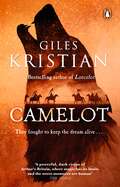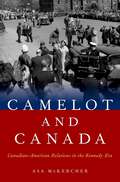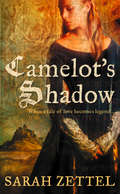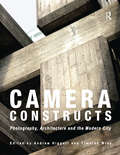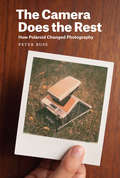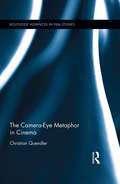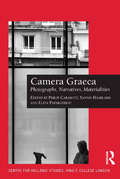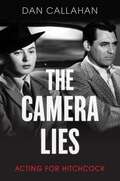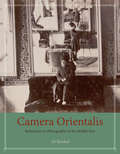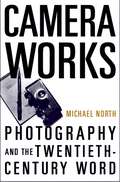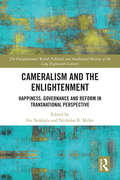- Table View
- List View
Camelot: The epic new novel from the author of Lancelot
by Giles Kristian'So beautiful, so haunting . . . bitingly real . . . Giles has given us a vital, glorious story: rich, rewarding, and utterly revealing of our times' Manda ScottFollowing his acclaimed Sunday Times bestseller, Lancelot, Giles Kristian's new novel returns us to the realms of Arthurian legend . . . Britain is a land riven by anarchy, slaughter, famine, filth and darkness. Its armies are destroyed, its heroes dead, or missing. Arthur and Lancelot fell in the last great battle and Merlin has not been seen these past ten years. Now, the Saxons are gathering again, their warbands stalk the land, their king seeks dominion. As for the lords and kings of Britain, they look only to their own survival and will not unite as they once did under Arthur and his legendary sword Excalibur.But in an isolated monastery in the marshes of Avalon, a novice of the order is preparing to take his vows when the life he has known is suddenly turned upside down in a welter of blood. Two strangers - the wild-spirited, Saxon-killing Iselle and the ageing warrior Gawain - will pluck the young man from the wreckage of his simple existence. Together, they will seek the last druid and the cauldron of a god. And the young man must come to terms with his legacy and fate as the son of the most celebrated yet most infamous of Arthur's warriors: Lancelot. For this is the story of Galahad, Lancelot’s son – the reluctant warrior who dared to keep the dream of Camelot alive . . . Acclaim for Lancelot: 'A masterpiece.' Conn Iggulden 'Stands head and shoulders above the rest.' Manda Scott'Glorious. Tragic. Lyrical. Totally gripping.' Ben Kane'A gorgeous, rich retelling.' The Times'An extraordinary writer . . . an exceptional book.' Dr Janina Ramirez
Camelot and Canada: Canadian-American Relations in the Kennedy Era
by Asa McKercherIn 1958 Senator John F. Kennedy of Massachusetts proclaimed at the University of New Brunswick that "Canada and the United States have carefully maintained the good fences that help make them good neighbours." He could not have foreseen that his presidency would be marked not just by some of the tensest moments of the Cold War but also by the most contentious moments in the Canadian-American relationship. Indeed, the 1963 Canadian federal election was marked by charges that the US government had engineered a plot to oust John Diefenbaker, Canada's nationalist prime minister. Camelot and Canada explores political, economic, and military elements in Canada-US relations in the early 1960s. Asa McKercher challenges the prevailing view that US foreign policymakers, including President Kennedy, were imperious in their conduct toward Canada. Rather, he shows that the period continued to be marked by the special diplomatic relationship that characterized the early postwar years. Even as Diefenbaker's government pursued distinct foreign and economic policies, American officials acknowledged that Canadian objectives legitimately differed from their own and adjusted their policies accordingly. Moreover, for all its bluster, Ottawa rarely moved without weighing the impact that its initiatives might have on Washington. At the same time, McKercher illustrates that there were significant strains on the bilateral relationship, which occurred as a result of mounting doubts in Canada about US leadership in the Cold War, growing Canadian nationalism, and Canadian concern over their country's close economic, military, and cultural ties with the United States. While personal clashes between the two leaders have become mythologized by historians and the public alike, the special relationship between their governments continued to function.
Camelot and Canada: Canadian-American Relations in the Kennedy Era
by Asa McKercherIn 1958 Senator John F. Kennedy of Massachusetts proclaimed at the University of New Brunswick that "Canada and the United States have carefully maintained the good fences that help make them good neighbours." He could not have foreseen that his presidency would be marked not just by some of the tensest moments of the Cold War but also by the most contentious moments in the Canadian-American relationship. Indeed, the 1963 Canadian federal election was marked by charges that the US government had engineered a plot to oust John Diefenbaker, Canada's nationalist prime minister. Camelot and Canada explores political, economic, and military elements in Canada-US relations in the early 1960s. Asa McKercher challenges the prevailing view that US foreign policymakers, including President Kennedy, were imperious in their conduct toward Canada. Rather, he shows that the period continued to be marked by the special diplomatic relationship that characterized the early postwar years. Even as Diefenbaker's government pursued distinct foreign and economic policies, American officials acknowledged that Canadian objectives legitimately differed from their own and adjusted their policies accordingly. Moreover, for all its bluster, Ottawa rarely moved without weighing the impact that its initiatives might have on Washington. At the same time, McKercher illustrates that there were significant strains on the bilateral relationship, which occurred as a result of mounting doubts in Canada about US leadership in the Cold War, growing Canadian nationalism, and Canadian concern over their country's close economic, military, and cultural ties with the United States. While personal clashes between the two leaders have become mythologized by historians and the public alike, the special relationship between their governments continued to function.
Camelot’s Shadow (The\paths To Camelot Ser. #Bk. 1)
by Sarah ZettelA stunning tale of romance and magic set against the legendary backdrop of King Arthur’s court.
Camera Constructs: Photography, Architecture and the Modern City
by Andrew Higgott Timothy WrayPhotography and architecture have a uniquely powerful resonance - architectural form provides the camera with the subject for some of its most compelling imagery, while photography profoundly influences how architecture is represented, imagined and produced. Camera Constructs is the first book to reflect critically on the varied interactions of the different practices by which photographers, artists, architects, theorists and historians engage with the relationship of the camera to architecture, the city and the evolution of Modernism. The title thus on the one hand opposes the medium of photography and the materiality of construction - but on the other can be read as saying that the camera invariably constructs what it depicts: the photograph is not a simple representation of an external reality, but constructs its own meanings and reconstructs its subjects. Twenty-three essays by a wide range of historians and theorists are grouped under the themes of ’Modernism and the Published Photograph’, ’Architecture and the City Re-imagined’, ’Interpretative Constructs’ and ’Photography in Design Practices.’ They are preceded by an Introduction that comprehensively outlines the subject and elaborates on the diverse historical and theoretical contexts of the authors’ approaches. Camera Constructs provides a rich and highly original analysis of the relationship of photography to built form from the early modern period to the present day.
Camera Constructs: Photography, Architecture and the Modern City
by Andrew Higgott Timothy WrayPhotography and architecture have a uniquely powerful resonance - architectural form provides the camera with the subject for some of its most compelling imagery, while photography profoundly influences how architecture is represented, imagined and produced. Camera Constructs is the first book to reflect critically on the varied interactions of the different practices by which photographers, artists, architects, theorists and historians engage with the relationship of the camera to architecture, the city and the evolution of Modernism. The title thus on the one hand opposes the medium of photography and the materiality of construction - but on the other can be read as saying that the camera invariably constructs what it depicts: the photograph is not a simple representation of an external reality, but constructs its own meanings and reconstructs its subjects. Twenty-three essays by a wide range of historians and theorists are grouped under the themes of ’Modernism and the Published Photograph’, ’Architecture and the City Re-imagined’, ’Interpretative Constructs’ and ’Photography in Design Practices.’ They are preceded by an Introduction that comprehensively outlines the subject and elaborates on the diverse historical and theoretical contexts of the authors’ approaches. Camera Constructs provides a rich and highly original analysis of the relationship of photography to built form from the early modern period to the present day.
The Camera Does the Rest: How Polaroid Changed Photography
by Peter BuseIn a world where nearly everyone has a cellphone camera capable of zapping countless instant photos, it can be a challenge to remember just how special and transformative Polaroid photography was in its day. And yet, there’s still something magical for those of us who recall waiting for a Polaroid picture to develop. Writing in the context of two Polaroid Corporation bankruptcies, not to mention the obsolescence of its film, Peter Buse argues that Polaroid was, and is, distinguished by its process—by the fact that, as the New York Times put it in 1947, “the camera does the rest.” Polaroid was often dismissed as a toy, but Buse takes it seriously, showing how it encouraged photographic play as well as new forms of artistic practice. Drawing on unprecedented access to the archives of the Polaroid Corporation, Buse reveals Polaroid as photography at its most intimate, where the photographer, photograph, and subject sit in close proximity in both time and space—making Polaroid not only the perfect party camera but also the tool for frankly salacious pictures taking. Along the way, Buse tells the story of the Polaroid Corporation and its ultimately doomed hard-copy wager against the rising tide of digital imaging technology. He explores the continuities and the differences between Polaroid and digital, reflecting on what Polaroid can tell us about how we snap photos today. Richly illustrated, The Camera Does the Rest will delight historians, art critics, analog fanatics, photographers, and all those who miss the thrill of waiting to see what develops.
The Camera Does the Rest: How Polaroid Changed Photography
by Peter BuseIn a world where nearly everyone has a cellphone camera capable of zapping countless instant photos, it can be a challenge to remember just how special and transformative Polaroid photography was in its day. And yet, there’s still something magical for those of us who recall waiting for a Polaroid picture to develop. Writing in the context of two Polaroid Corporation bankruptcies, not to mention the obsolescence of its film, Peter Buse argues that Polaroid was, and is, distinguished by its process—by the fact that, as the New York Times put it in 1947, “the camera does the rest.” Polaroid was often dismissed as a toy, but Buse takes it seriously, showing how it encouraged photographic play as well as new forms of artistic practice. Drawing on unprecedented access to the archives of the Polaroid Corporation, Buse reveals Polaroid as photography at its most intimate, where the photographer, photograph, and subject sit in close proximity in both time and space—making Polaroid not only the perfect party camera but also the tool for frankly salacious pictures taking. Along the way, Buse tells the story of the Polaroid Corporation and its ultimately doomed hard-copy wager against the rising tide of digital imaging technology. He explores the continuities and the differences between Polaroid and digital, reflecting on what Polaroid can tell us about how we snap photos today. Richly illustrated, The Camera Does the Rest will delight historians, art critics, analog fanatics, photographers, and all those who miss the thrill of waiting to see what develops.
The Camera Does the Rest: How Polaroid Changed Photography
by Peter BuseIn a world where nearly everyone has a cellphone camera capable of zapping countless instant photos, it can be a challenge to remember just how special and transformative Polaroid photography was in its day. And yet, there’s still something magical for those of us who recall waiting for a Polaroid picture to develop. Writing in the context of two Polaroid Corporation bankruptcies, not to mention the obsolescence of its film, Peter Buse argues that Polaroid was, and is, distinguished by its process—by the fact that, as the New York Times put it in 1947, “the camera does the rest.” Polaroid was often dismissed as a toy, but Buse takes it seriously, showing how it encouraged photographic play as well as new forms of artistic practice. Drawing on unprecedented access to the archives of the Polaroid Corporation, Buse reveals Polaroid as photography at its most intimate, where the photographer, photograph, and subject sit in close proximity in both time and space—making Polaroid not only the perfect party camera but also the tool for frankly salacious pictures taking. Along the way, Buse tells the story of the Polaroid Corporation and its ultimately doomed hard-copy wager against the rising tide of digital imaging technology. He explores the continuities and the differences between Polaroid and digital, reflecting on what Polaroid can tell us about how we snap photos today. Richly illustrated, The Camera Does the Rest will delight historians, art critics, analog fanatics, photographers, and all those who miss the thrill of waiting to see what develops.
The Camera Does the Rest: How Polaroid Changed Photography
by Peter BuseIn a world where nearly everyone has a cellphone camera capable of zapping countless instant photos, it can be a challenge to remember just how special and transformative Polaroid photography was in its day. And yet, there’s still something magical for those of us who recall waiting for a Polaroid picture to develop. Writing in the context of two Polaroid Corporation bankruptcies, not to mention the obsolescence of its film, Peter Buse argues that Polaroid was, and is, distinguished by its process—by the fact that, as the New York Times put it in 1947, “the camera does the rest.” Polaroid was often dismissed as a toy, but Buse takes it seriously, showing how it encouraged photographic play as well as new forms of artistic practice. Drawing on unprecedented access to the archives of the Polaroid Corporation, Buse reveals Polaroid as photography at its most intimate, where the photographer, photograph, and subject sit in close proximity in both time and space—making Polaroid not only the perfect party camera but also the tool for frankly salacious pictures taking. Along the way, Buse tells the story of the Polaroid Corporation and its ultimately doomed hard-copy wager against the rising tide of digital imaging technology. He explores the continuities and the differences between Polaroid and digital, reflecting on what Polaroid can tell us about how we snap photos today. Richly illustrated, The Camera Does the Rest will delight historians, art critics, analog fanatics, photographers, and all those who miss the thrill of waiting to see what develops.
The Camera-Eye Metaphor in Cinema (Routledge Advances in Film Studies)
by Christian QuendlerThis book explores the cultural, intellectual, and artistic fascination with camera-eye metaphors in film culture of the twentieth century. By studying the very metaphor that cinema lives by, it provides a rich and insightful map of our understanding of cinema and film styles and shows how cinema shapes our understanding of the arts and media. As current new media technologies are attempting to shift the identity of cinema and moving imagery, it is hard to overstate the importance of this metaphor for our understanding of the modalities of vision. In what guises does the "camera eye" continue to survive in media that is called new?
The Camera-Eye Metaphor in Cinema (Routledge Advances in Film Studies)
by Christian QuendlerThis book explores the cultural, intellectual, and artistic fascination with camera-eye metaphors in film culture of the twentieth century. By studying the very metaphor that cinema lives by, it provides a rich and insightful map of our understanding of cinema and film styles and shows how cinema shapes our understanding of the arts and media. As current new media technologies are attempting to shift the identity of cinema and moving imagery, it is hard to overstate the importance of this metaphor for our understanding of the modalities of vision. In what guises does the "camera eye" continue to survive in media that is called new?
Camera Graeca: Photographs, Narratives, Materialities (Publications of the Centre for Hellenic Studies, King's College London #16)
by Philip Carabott Yannis Hamilakis Eleni PapargyriouWhile written sources on the history of Greece have been studied extensively, no systematic attempt has been made to examine photography as an important cultural and material process. This is surprising, given that Modern Greece and photography are almost peers: both are cultural products of the 1830s, and both actively converse with modernity. Camera Graeca: Photographs, Narratives, Materialities fills this lacuna. It is the first inter-disciplinary volume to examine critically and in a theorised manner the entanglement of Greece with photography. The book argues that photographs and the photographic process as a whole have been instrumental in the reproduction of national imagination, in the consolidation of the nation-building process, and in the generation and dissemination of state propaganda. At the same time, it is argued that the photographic field constitutes a site of memory and counter-memory, where various social actors intervene actively and stake their discursive, material, and practical claims. As such, the volume will be of relevance to scholars and photographers, worldwide. The book is divided into four, tightly integrated parts. The first, ’Imag(in)ing Greece’, shows that the consolidation of Greek national identity constituted a material-cum-representational process, the projection of an imagery, although some photographic production sits uneasily within the national canon, and may even undermine it. The second part, ’Photographic narratives, alternative histories’, demonstrates the narrative function of photographs in diary-keeping and in photobooks. It also examines the constitution of spectatorship through the combination of text and image, and the role of photography as a process of materializing counter-hegemonic discourses and practices. The third part, ’Photographic matter-realities’, foregrounds the role of photography in materializing state propaganda, national memory, and war. The final part, ’Photographic ethnographiesâ
Camera Graeca: Photographs, Narratives, Materialities (Publications of the Centre for Hellenic Studies, King's College London #16)
by Philip Carabott Yannis Hamilakis Eleni PapargyriouWhile written sources on the history of Greece have been studied extensively, no systematic attempt has been made to examine photography as an important cultural and material process. This is surprising, given that Modern Greece and photography are almost peers: both are cultural products of the 1830s, and both actively converse with modernity. Camera Graeca: Photographs, Narratives, Materialities fills this lacuna. It is the first inter-disciplinary volume to examine critically and in a theorised manner the entanglement of Greece with photography. The book argues that photographs and the photographic process as a whole have been instrumental in the reproduction of national imagination, in the consolidation of the nation-building process, and in the generation and dissemination of state propaganda. At the same time, it is argued that the photographic field constitutes a site of memory and counter-memory, where various social actors intervene actively and stake their discursive, material, and practical claims. As such, the volume will be of relevance to scholars and photographers, worldwide. The book is divided into four, tightly integrated parts. The first, ’Imag(in)ing Greece’, shows that the consolidation of Greek national identity constituted a material-cum-representational process, the projection of an imagery, although some photographic production sits uneasily within the national canon, and may even undermine it. The second part, ’Photographic narratives, alternative histories’, demonstrates the narrative function of photographs in diary-keeping and in photobooks. It also examines the constitution of spectatorship through the combination of text and image, and the role of photography as a process of materializing counter-hegemonic discourses and practices. The third part, ’Photographic matter-realities’, foregrounds the role of photography in materializing state propaganda, national memory, and war. The final part, ’Photographic ethnographiesâ
The Camera Lies: Acting for Hitchcock
by Dan CallahanThe first book on Hitchcock that focuses exclusively on his work with actors Alfred Hitchcock is said to have once remarked, "Actors are cattle," a line that has stuck in the public consciousness ever since. For Hitchcock, acting was a matter of contrast and counterpoint, valuing subtlety and understatement over flashiness. He felt that the camera was duplicitous, and directed actors to look and act conversely. In The Camera Lies, author Dan Callahan spotlights the many nuances of Hitchcock's direction throughout his career, from Cary Grant in Notorious (1946) to Janet Leigh in Psycho (1960). Delving further, he examines the ways that sex and sexuality are presented through Hitchcock's characters, reflecting the director's own complex relationship with sexuality. Detailing the fluidity of acting -- both what it means to act on film and how the process varies in each actor's career -- Callahan examines the spectrum of treatment and direction Hitchcock provided well- and lesser-known actors alike, including Ingrid Bergman, Henry Kendall, Joan Barry, Robert Walker, Jessica Tandy, Kim Novak, and Tippi Hedren. As Hitchcock believed, the best actor was one who could "do nothing well" - but behind an outward indifference to his players was a sophisticated acting theorist who often drew out great performances. The Camera Lies unpacks Hitchcock's legacy both as a director who continuously taught audiences to distrust appearance, and as a man with an uncanny insight into the human capacity for deceit and misinterpretation.
The Camera Lies: Acting for Hitchcock
by Dan CallahanThe first book on Hitchcock that focuses exclusively on his work with actors Alfred Hitchcock is said to have once remarked, "Actors are cattle," a line that has stuck in the public consciousness ever since. For Hitchcock, acting was a matter of contrast and counterpoint, valuing subtlety and understatement over flashiness. He felt that the camera was duplicitous, and directed actors to look and act conversely. In The Camera Lies, author Dan Callahan spotlights the many nuances of Hitchcock's direction throughout his career, from Cary Grant in Notorious (1946) to Janet Leigh in Psycho (1960). Delving further, he examines the ways that sex and sexuality are presented through Hitchcock's characters, reflecting the director's own complex relationship with sexuality. Detailing the fluidity of acting -- both what it means to act on film and how the process varies in each actor's career -- Callahan examines the spectrum of treatment and direction Hitchcock provided well- and lesser-known actors alike, including Ingrid Bergman, Henry Kendall, Joan Barry, Robert Walker, Jessica Tandy, Kim Novak, and Tippi Hedren. As Hitchcock believed, the best actor was one who could "do nothing well" - but behind an outward indifference to his players was a sophisticated acting theorist who often drew out great performances. The Camera Lies unpacks Hitchcock's legacy both as a director who continuously taught audiences to distrust appearance, and as a man with an uncanny insight into the human capacity for deceit and misinterpretation.
Camera Orientalis: Reflections on Photography of the Middle East
by Ali BehdadIn the decades after its invention in 1839, photography was inextricably linked to the Middle East. Introduced as a crucial tool for Egyptologists and Orientalists who needed to document their archaeological findings, the photograph was easier and faster to produce in intense Middle Eastern light—making the region one of the original sites for the practice of photography. A pioneering study of this intertwined history, Camera Orientalis traces the Middle East’s influences on photography’s evolution, as well as photography’s effect on Europe’s view of “the Orient.” Considering a range of Western and Middle Eastern archival material from the late nineteenth and early twentieth centuries, Ali Behdad offers a rich account of how photography transformed Europe’s distinctly Orientalist vision into what seemed objective fact, a transformation that proved central to the project of European colonialism. At the same time, Orientalism was useful for photographers from both regions, as it gave them a set of conventions by which to frame exotic Middle Eastern cultures for Western audiences. Behdad also shows how Middle Eastern audiences embraced photography as a way to foreground status and patriarchal values while also exoticizing other social classes. An important examination of previously overlooked European and Middle Eastern photographers and studios, Camera Orientalis demonstrates that, far from being a one-sided European development, Orientalist photography was the product of rich cultural contact between the East and the West.
Camera Orientalis: Reflections on Photography of the Middle East
by Ali BehdadIn the decades after its invention in 1839, photography was inextricably linked to the Middle East. Introduced as a crucial tool for Egyptologists and Orientalists who needed to document their archaeological findings, the photograph was easier and faster to produce in intense Middle Eastern light—making the region one of the original sites for the practice of photography. A pioneering study of this intertwined history, Camera Orientalis traces the Middle East’s influences on photography’s evolution, as well as photography’s effect on Europe’s view of “the Orient.” Considering a range of Western and Middle Eastern archival material from the late nineteenth and early twentieth centuries, Ali Behdad offers a rich account of how photography transformed Europe’s distinctly Orientalist vision into what seemed objective fact, a transformation that proved central to the project of European colonialism. At the same time, Orientalism was useful for photographers from both regions, as it gave them a set of conventions by which to frame exotic Middle Eastern cultures for Western audiences. Behdad also shows how Middle Eastern audiences embraced photography as a way to foreground status and patriarchal values while also exoticizing other social classes. An important examination of previously overlooked European and Middle Eastern photographers and studios, Camera Orientalis demonstrates that, far from being a one-sided European development, Orientalist photography was the product of rich cultural contact between the East and the West.
Camera Orientalis: Reflections on Photography of the Middle East
by Ali BehdadIn the decades after its invention in 1839, photography was inextricably linked to the Middle East. Introduced as a crucial tool for Egyptologists and Orientalists who needed to document their archaeological findings, the photograph was easier and faster to produce in intense Middle Eastern light—making the region one of the original sites for the practice of photography. A pioneering study of this intertwined history, Camera Orientalis traces the Middle East’s influences on photography’s evolution, as well as photography’s effect on Europe’s view of “the Orient.” Considering a range of Western and Middle Eastern archival material from the late nineteenth and early twentieth centuries, Ali Behdad offers a rich account of how photography transformed Europe’s distinctly Orientalist vision into what seemed objective fact, a transformation that proved central to the project of European colonialism. At the same time, Orientalism was useful for photographers from both regions, as it gave them a set of conventions by which to frame exotic Middle Eastern cultures for Western audiences. Behdad also shows how Middle Eastern audiences embraced photography as a way to foreground status and patriarchal values while also exoticizing other social classes. An important examination of previously overlooked European and Middle Eastern photographers and studios, Camera Orientalis demonstrates that, far from being a one-sided European development, Orientalist photography was the product of rich cultural contact between the East and the West.
Camera Orientalis: Reflections on Photography of the Middle East
by Ali BehdadIn the decades after its invention in 1839, photography was inextricably linked to the Middle East. Introduced as a crucial tool for Egyptologists and Orientalists who needed to document their archaeological findings, the photograph was easier and faster to produce in intense Middle Eastern light—making the region one of the original sites for the practice of photography. A pioneering study of this intertwined history, Camera Orientalis traces the Middle East’s influences on photography’s evolution, as well as photography’s effect on Europe’s view of “the Orient.” Considering a range of Western and Middle Eastern archival material from the late nineteenth and early twentieth centuries, Ali Behdad offers a rich account of how photography transformed Europe’s distinctly Orientalist vision into what seemed objective fact, a transformation that proved central to the project of European colonialism. At the same time, Orientalism was useful for photographers from both regions, as it gave them a set of conventions by which to frame exotic Middle Eastern cultures for Western audiences. Behdad also shows how Middle Eastern audiences embraced photography as a way to foreground status and patriarchal values while also exoticizing other social classes. An important examination of previously overlooked European and Middle Eastern photographers and studios, Camera Orientalis demonstrates that, far from being a one-sided European development, Orientalist photography was the product of rich cultural contact between the East and the West.
Camera Orientalis: Reflections on Photography of the Middle East
by Ali BehdadIn the decades after its invention in 1839, photography was inextricably linked to the Middle East. Introduced as a crucial tool for Egyptologists and Orientalists who needed to document their archaeological findings, the photograph was easier and faster to produce in intense Middle Eastern light—making the region one of the original sites for the practice of photography. A pioneering study of this intertwined history, Camera Orientalis traces the Middle East’s influences on photography’s evolution, as well as photography’s effect on Europe’s view of “the Orient.” Considering a range of Western and Middle Eastern archival material from the late nineteenth and early twentieth centuries, Ali Behdad offers a rich account of how photography transformed Europe’s distinctly Orientalist vision into what seemed objective fact, a transformation that proved central to the project of European colonialism. At the same time, Orientalism was useful for photographers from both regions, as it gave them a set of conventions by which to frame exotic Middle Eastern cultures for Western audiences. Behdad also shows how Middle Eastern audiences embraced photography as a way to foreground status and patriarchal values while also exoticizing other social classes. An important examination of previously overlooked European and Middle Eastern photographers and studios, Camera Orientalis demonstrates that, far from being a one-sided European development, Orientalist photography was the product of rich cultural contact between the East and the West.
Camera Orientalis: Reflections on Photography of the Middle East
by Ali BehdadIn the decades after its invention in 1839, photography was inextricably linked to the Middle East. Introduced as a crucial tool for Egyptologists and Orientalists who needed to document their archaeological findings, the photograph was easier and faster to produce in intense Middle Eastern light—making the region one of the original sites for the practice of photography. A pioneering study of this intertwined history, Camera Orientalis traces the Middle East’s influences on photography’s evolution, as well as photography’s effect on Europe’s view of “the Orient.” Considering a range of Western and Middle Eastern archival material from the late nineteenth and early twentieth centuries, Ali Behdad offers a rich account of how photography transformed Europe’s distinctly Orientalist vision into what seemed objective fact, a transformation that proved central to the project of European colonialism. At the same time, Orientalism was useful for photographers from both regions, as it gave them a set of conventions by which to frame exotic Middle Eastern cultures for Western audiences. Behdad also shows how Middle Eastern audiences embraced photography as a way to foreground status and patriarchal values while also exoticizing other social classes. An important examination of previously overlooked European and Middle Eastern photographers and studios, Camera Orientalis demonstrates that, far from being a one-sided European development, Orientalist photography was the product of rich cultural contact between the East and the West.
Camera Works: Photography and the Twentieth-Century Word
by Michael NorthCamera Works is about the impact of photography and film on modern art and literature. For many artists and writers, these new media offered hope of new means of representation, neither linguistic nor pictorial, but hovering in a kind of utopian space between. At the same time, the new media introduced a dramatic element of novelty into the age-old evidence of the senses. For the avant-garde, the challenges of the new media were the modern in its most concentrated form, but even for aesthetically unadventurous writers they constituted an element of modern experience that could hardly be ignored. Camera Works thus traces some of the more utopian projects of transatlantic avant-garde, including the Readie machine of Bob Brown, which was to turn stories and poems into strips of linguistic film. The influence of photography and film on the avant-garde is traced from the early days of Camera Work, through the enthusiasm of Eugene Jolas and the contributors to his magazine transition, to the crisis created by the introduction of sound in the late 1920's. Subseguent chapters describe the entirely new kind of sensory enjoyment brought into modern American fiction by the new media. What Fitzgerald calls "spectroscopic gayety," the enjoyable diorientation of the senses by machine perception, turns out to be a powerful force in much American fiction. The revolutionary possibilities of this new spectatorship and its limitations are pursued through a number of examples, including Dos Passos, James Weldon Johnson, and Hemingway. Together, these chapters offer a new and substantially different account of the relationship between modern American literature and the mediatized society of the early twentieth century. With a comprehensive introduction and detailed particular readings, Camera Works substantiates a new understanding of the formal and historical bases of modernism. It argues that when modern literature and art respond to modernity, on a formal level, they are responding to the intervention of technology in the transmission of meaning, an intervention that unsettles all the terms in the essential relationship of human consciousness to the world of phenomena.
Cameralism and the Enlightenment: Happiness, Governance and Reform in Transnational Perspective (The Enlightenment World)
by Ere Nokkala Nicholas B. MillerCameralism and the Enlightenment reassesses the relationship between two key phenomena of European history often disconnected from each other. It builds on recent insights from global history, transnational history and Enlightenment studies to reflect on the dynamic interactions of cameralism, an early modern set of practices and discourses of statecraft prominent in central Europe, with the broader political, intellectual and cultural developments of the Enlightenment world. Through contributions from prominent scholars across the field of Enlightenment studies, the volume analyzes eighteenth-century cameralist authors’ engagements with commerce, colonialism and natural law. Challenging the caricature of cameralism as a German, land-locked version of mercantilism, the volume reframes its importance for scholars of the Enlightenment broadly conceived. This volume goes beyond the typical focus on Britain and France in studies of political economy, widening perspectives about the dissemination of ideas of governance, happiness and reform to focus on multidirectional exchanges across continental Europe and beyond during the eighteenth century. Emphasizing the practice of theory, it proposes the study of the porosity of ideas in their exchange, transmission and mediation between spaces and discourses as a key dimension of cultural and intellectual history.
